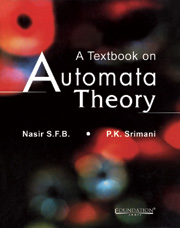Book contents
- Frontmatter
- Contents
- Preface
- Acknowledgements
- List of Abbreviations
- 1 Fundamentals of Automata
- 2 Formal Language Theory
- 3 Regular Expressions and Languages
- 4 Finite Automata
- 5 Equivalent Automata
- 6 Minimisation/Optimisation of DFA
- 7 Finite Automata and Regular Expressions
- 8 Transducers
- 9 Context-Free Grammars and Context-Free Languages
- 10 Simplification of Context-Free Grammar
- 11 Pushdown Automata
- 12 Pumping Lemma
- 13 Turing Machine
- 14 TM Extensions and Languages
- 15 Formal Languages/Grammar Hierarchy
- Appendix A Symbol Chart
- Appendix B Sets, Relations, Functions and Mathematical Induction
- Appendix C System Modelling
- Index
6 - Minimisation/Optimisation of DFA
Published online by Cambridge University Press: 26 October 2011
- Frontmatter
- Contents
- Preface
- Acknowledgements
- List of Abbreviations
- 1 Fundamentals of Automata
- 2 Formal Language Theory
- 3 Regular Expressions and Languages
- 4 Finite Automata
- 5 Equivalent Automata
- 6 Minimisation/Optimisation of DFA
- 7 Finite Automata and Regular Expressions
- 8 Transducers
- 9 Context-Free Grammars and Context-Free Languages
- 10 Simplification of Context-Free Grammar
- 11 Pushdown Automata
- 12 Pumping Lemma
- 13 Turing Machine
- 14 TM Extensions and Languages
- 15 Formal Languages/Grammar Hierarchy
- Appendix A Symbol Chart
- Appendix B Sets, Relations, Functions and Mathematical Induction
- Appendix C System Modelling
- Index
Summary
‘Enjoy the power of problem-solving techniques; get optimal results.’
Introduction
In this chapter, we briefly sample a few additional topics in DFA, which are of interest.
Optimum DFA
It is possible to have more than one DFAs that accept the same language. Among these equivalent DFAs, it is often useful to find the smallest, i.e., the DFA with the minimum possible number of states. This is especially important, when DFAs are used for designing computer hardware circuits.
Definition
Minimisation/optimisation of a deterministic finite automaton refers to the detection of those states of a DFA, whose presence or absence in a DFA does not affect the language accepted by the automata.
The states that can be eliminated from automata, without affecting the language accepted
by automata, are:
▪Unreachable or inaccessible states.
▪Dead states.
▪Non-distinguishable or indistinguishable state or equivalent states.
Unreachable States
These are the states that cannot possibly be reached from the initial state. Unreachable states of a DFA are not reachable from the initial state of DFA, by any possible input sequence.
EXAMPLE 6.1.1: (Unreachable states)
i. Here, state 5 is unreachable, from the initial state 0, with any input string (either b or a).
ii. Here, states q2 and q4 are unreachable, from the initial state q0, with any input string (0 or 1).
Dead State or Trap State
A state is dead, if it is not an accepting state and has no out-going transitions, except to itself. Alternatively, a dead state is a nonfinal state of a DFA, whose transitions on every input symbol terminates on itself.
- Type
- Chapter
- Information
- A Textbook on Automata Theory , pp. 205 - 231Publisher: Foundation BooksPrint publication year: 2007

